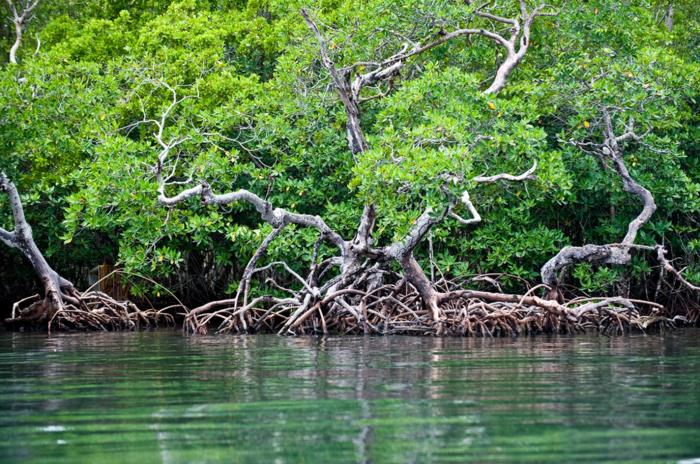A tiny Central American country is charting a path to slowing climate change, while boosting the economy and making communities safer. A new Stanford-led study quantifies the value of Belize’s coastal mangrove forests in terms of how much carbon they can hold, the value they can add to tourism and fisheries, and the protection they can provide against coastal storms and other risks. Importantly, the findings, published June 1 in Nature Ecology and Evolution, have already provided a basis for Belize’s commitment to protect or restore additional mangrove forests totaling an area about the size of Washington, D.C., by 2030. The approach holds lessons for many other coastal countries.

Credit: ©Antonio Busiello / WWF
A tiny Central American country is charting a path to slowing climate change, while boosting the economy and making communities safer. A new Stanford-led study quantifies the value of Belize’s coastal mangrove forests in terms of how much carbon they can hold, the value they can add to tourism and fisheries, and the protection they can provide against coastal storms and other risks. Importantly, the findings, published June 1 in Nature Ecology and Evolution, have already provided a basis for Belize’s commitment to protect or restore additional mangrove forests totaling an area about the size of Washington, D.C., by 2030. The approach holds lessons for many other coastal countries.
“The U.S. has one of the largest coastlines in the world, and extensive wetlands,” said study lead author Katie Arkema, a scientist at the Stanford Natural Capital Project at the time of the research, now at the Pacific Northwest National Laboratory and the University of Washington. “This paper offers an approach we could use for setting evidence-based climate resilience and economic development goals.”
Many countries have been struggling to meet their international climate commitments. Nature-based solutions, such as locking up or sequestering carbon in mangroves, seagrasses, and salt marshes, provide a promising solution – they help nations reduce their greenhouse gas emissions and also adapt to climate change. Yet, major coastal countries, including the U.S., have largely overlooked these so-called blue carbon strategies. The oversight is due in part to the complexity of calculating how much carbon wetlands and other coastal ecosystems can sequester, and where to implement these strategies to maximize co-benefits for the economy, flood risk reduction, and other sectors.
Maximizing benefits
Working together with other scientists, as well as Belizean policymakers and stakeholders, the researchers quantified carbon storage and sequestration using land cover data from Belize and field estimates from Mexico. They quantified coastal flood risk reduction, tourism, and fisheries co-benefits by modeling related services – such as lobster breeding grounds – provided by mangroves currently and under future protection and restoration scenarios at various locations.
Among their findings: In some areas, relatively small amounts of mangrove restoration can have big tourism and fisheries benefits. In contrast, total organic carbon sequestration is initially lower when restoring mangrove areas than when protecting existing forests because it takes time for carbon stocks to accumulate in the soil and biomass.
Another key takeaway: The rate of increase for benefits other than carbon storage begins to decrease at a certain point as mangrove area continues to increase. Predicting these inflection points can help stakeholders and policymakers decide how to most effectively balance ecosystem protection with coastal development. Similarly, identifying locations where blue carbon strategies would provide the greatest delivery of co-benefits can help bolster local support.
Based on the findings, Belizean policymakers pledged to protect an additional 46 square miles of existing mangroves – bringing the national total under protection to 96 square miles – and to restore 15 square miles of mangroves by 2030. If realized, the effort will not only store and sequester millions of tons of carbon but also boost lobster fisheries by as much as 66%, generate mangrove tourism worth several million dollars annually, and reduce the risk of coastal hazards for at least 30% more people, according to the researchers’ models.
The numbers are significant for a country with a population smaller than Tulsa, Oklahoma, and a GDP equivalent to about 2% of New York City’s annual budget.
Because the approach addresses both climate and sustainable development goals, it opens new opportunities for financing nature-based solutions in countries like Belize. In the months to come, the Natural Capital Project, the InterAmerican Development Bank, and the Asian Development Bank will work with 10 countries, including Belize, to support the mainstreaming of and accounting for such nature-based approaches into policy and investment decision-making processes (read more).
“Belize’s example, illustrating the practical ways nature’s many benefits can be spatially quantified and inform a country’s climate policy and investments, are now primed to be scaled around the world with development banks and country leaders” said study co-author Mary Ruckelshaus, executive director of the Stanford Natural Capital Project.
The study was funded by the Gordon and Betty Moore Foundation, the Pew Charitable Trusts, and the World Wildlife Fund.
Study co-authors also include Jade Delevaux of the Natural Capital Project; Jessica Silver and Samantha Winder of the Natural Capital Project and the University of Washington; and researchers with Silvestrum Climate Associates, the World Wildlife Fund, the Pew Charitable Trusts, the University of Minnesota, Belize’s National Climate Change Office, and Belize’s Coastal Zone Management Authority and Institute.
Journal
Nature Ecology & Evolution
Article Publication Date
1-Jun-2023




